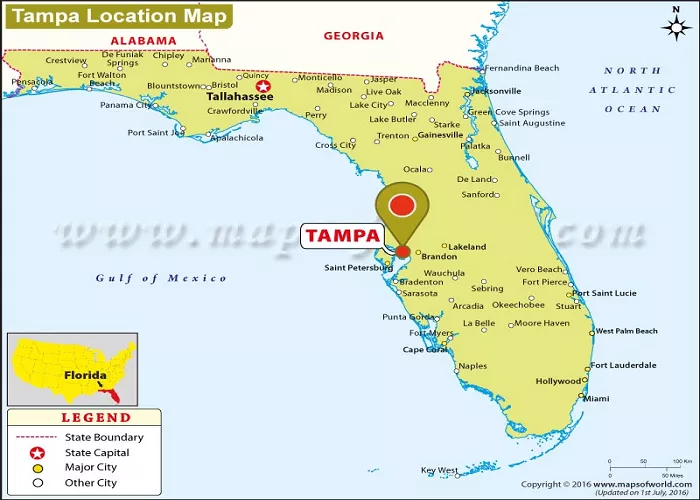Tampa is a vibrant city located on the Gulf Coast of Florida, United States. As the county seat of Hillsborough County, it serves as a significant cultural and economic hub in the region. Understanding Tampa’s geographical location provides insight into its development, climate, and the lifestyle of its residents.
Geographical Location
Situated along the north shore of Tampa Bay and the east shore of Old Tampa Bay, the city covers approximately 175.83 square miles, with 114.02 square miles being land and 61.82 square miles water. This positioning offers a unique blend of urban living and waterfront access.
Coordinates and Elevation
Tampa is geographically positioned at a latitude of 27.9475° N and a longitude of 82.4586° W. The city lies at an elevation of approximately 30 meters (98 feet) above sea level, contributing to its flat terrain.
Surrounding Regions
To the east, Tampa is bordered by the city of Temple Terrace and the unincorporated community of East Lake-Orient Park. The western boundary is defined by Tampa Bay, providing access to the Gulf of Mexico. To the north, it shares borders with the city of Carrollwood and the unincorporated community of Northdale. The southern border adjoins the city of Palmetto and the unincorporated community of Progress Village.
Climate and Weather
Tampa enjoys a humid subtropical climate, characterized by hot, humid summers and mild, dry winters. The city experiences a significant amount of sunshine throughout the year, making it an attractive destination for those seeking warm weather.
- Summer (June to September): Summers in Tampa are hot and humid, with average high temperatures ranging from 89°F to 92°F (32°C to 33°C). Afternoon thunderstorms are common during this season, providing relief from the heat.
- Winter (December to February): Winters are mild and dry, with average high temperatures ranging from 70°F to 74°F (21°C to 23°C). This is the most pleasant time of the year, attracting many visitors from colder regions.
- Rainfall: Tampa receives an average annual rainfall of about 46 inches (117 cm), with the majority of the precipitation occurring during the summer months.
- Hurricane Season: Tampa is also located in a region that can be affected by hurricanes, particularly during the Atlantic hurricane season, which runs from June 1 to November 30. While direct hits are rare, the city has experienced several close calls and has well-established emergency preparedness plans.
Accessibility and Transportation
Tampa’s strategic location along major highways such as Interstate 4 (I-4) and Interstate 275 (I-275) facilitates easy access to other parts of Florida. For instance, traveling from Orlando involves taking I-4 West directly into Tampa. Additionally, Tampa International Airport connects the city to various domestic and international destinations, enhancing its status as a transportation hub.
History and Cultural Significance
Tampa has a rich history that dates back to the indigenous peoples who originally inhabited the area. The city’s name is believed to have originated from the Calusa language, meaning “sticks of fire,” possibly referring to lightning strikes that were common in the region.
- Early History: The area was first explored by Spanish explorers in the 16th century. However, it wasn’t until the 19th century that Tampa began to develop as a significant settlement. The establishment of Fort Brooke in 1824 marked the beginning of Tampa’s growth as a military outpost and trading center.
- Cigar Industry: In the late 19th and early 20th centuries, Tampa became known as the “Cigar Capital of the World.” The city’s Ybor City district was home to numerous cigar factories, attracting immigrants from Cuba, Spain, and Italy. This cultural melting pot has left a lasting impact on Tampa’s identity, with Ybor City now recognized as a National Historic Landmark District.
- Modern Era: Today, Tampa is a thriving metropolitan area with a diverse economy that includes finance, healthcare, technology, and tourism. The city is also home to several major sports teams, including the Tampa Bay Buccaneers (NFL), Tampa Bay Lightning (NHL), and Tampa Bay Rays (MLB).
Conclusion
Tampa’s location on Florida’s Gulf Coast, coupled with its strategic position along major waterways and transportation routes, has played a pivotal role in its growth and development. Understanding where Tampa is situated offers valuable insights into its cultural significance, economic activities, and the lifestyle of its residents.

